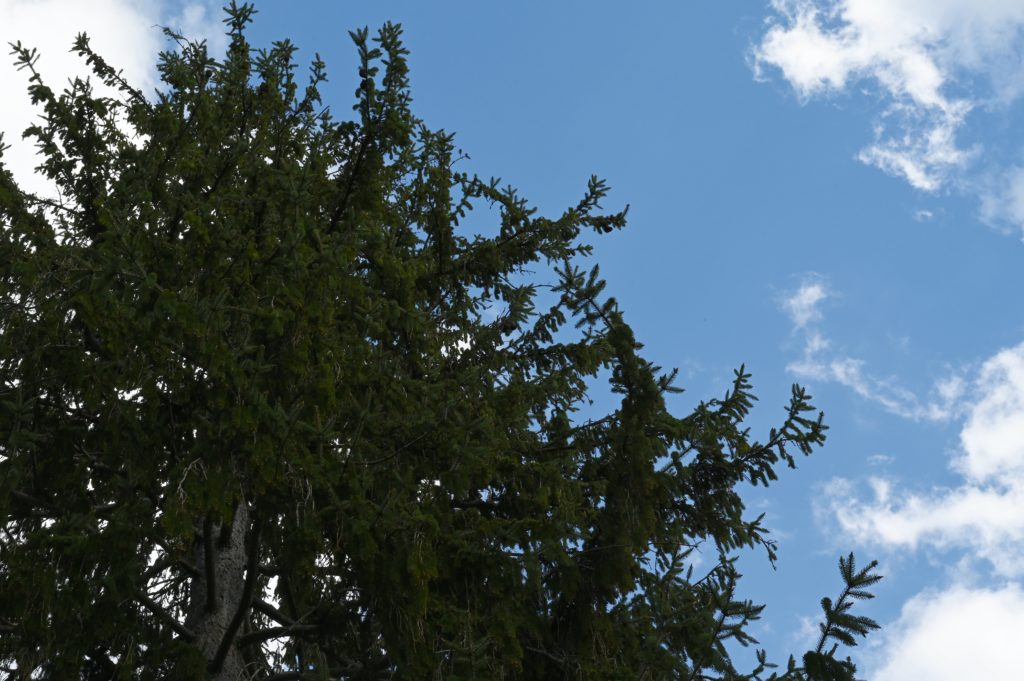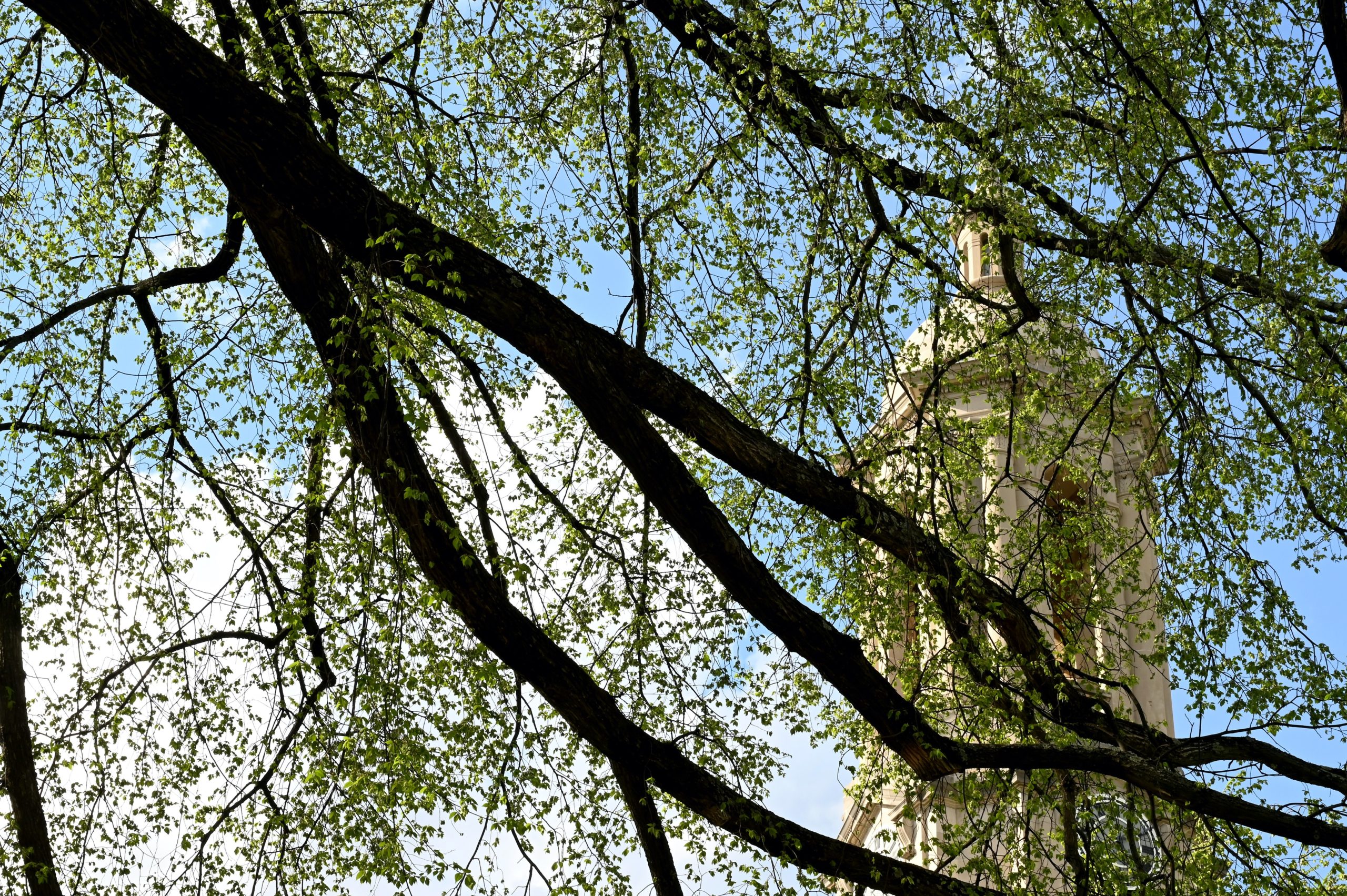Penn State University is known for many things – athletics, academics, student life. But an unmistakable, yet often overlooked highlight of the campus is its landscape, including more than 17,000 trees.
Twenty-one of those trees currently hold a more specific title: Heritage Trees. To gain such status, a tree must meet one of three criteria regarding its historical, cultural, or aesthetic value, says landscape architect Tom Flynn of Penn State’s Office of the Physical Plant.
“When it comes right down to it, the Heritage Trees are, without a doubt, our most important trees on campus,” Flynn says.
In order for age to be a tree’s qualifying factor, the tree must be at least 100 years old, Flynn says. The list does contain younger trees, however, that hold the title because of the irreplaceable aesthetic value they provide or because of the cultural significance.

Old Main, have been enjoyed by generations of Penn Staters. (Photo by Grace Miller)
A key player in deciding which trees are Heritage Trees is the University Tree Commission. The commission, formed in 2001, includes nine members with expertise in subjects like horticulture or landscape architecture, along with a student representative.
In addition to naming individual trees, the commission identifies groves of trees as Heritage Groves, meaning that the value the group of trees provides as a whole is irreplaceable.
On March 26, a well-known Heritage Tree named “Old Willow” fell in a windstorm. Old Willow was the third generation of its line, according to a Penn State press release, first having been planted in 1859. Old Willow became entwined in Penn State tradition, as freshmen passed underneath the tree’s canopy and bowed their heads to the tree originally believed to have been brought to campus by the university’s first president, Evan Pugh. Old Willow was designated as a Heritage Tree because of its cultural significance. Cuttings from the tree will be used to grow a fourth-generation Old Willow.
Generally, Flynn says, the commission decides which trees to add or remove from the university’s campus. More specifically, one job of board members is to make recommendations regarding the health of the trees. If there is a diseased tree, they work with OPP to see if the tree can be saved or if it must be removed. That has been a prominent concern of the commission lately, he says, because of some “pretty significant pests.”
For example, Flynn says that for decades, the university battled Dutch elm disease, which claimed close to half of Penn State’s elm trees.
One potential cause of concern right now, though Flynn says the commission hasn’t run into it yet, is the spotted lantern fly, an invasive insect that destroys many of Pennsylvania’s plant species.
“We’re just kind of bracing ourselves for that one,” Flynn says.
Bill Elmendorf, who says his last name translates to “elm of the village,” is the chair of the University Tree Commission, as well as a Penn State professor of community forestry and a past chair and current member of State College Borough’s Tree Commission.
A Heritage Tree is about more than just a title, as the policy states the designation ensures the university would “incur the costs” of maintaining that tree, Flynn says. The designation adds an extra level of oversight if that tree was to be considered for removal. In addition, Heritage Trees should also have plaques at the base, Flynn says, but because of funding, not all have them.

Though Heritage Trees are technically prioritized, Flynn says the university’s ground staff and crew take good care of all trees at Penn State.
“They are able to look at every single tree on campus and see the value in it, whether it’s heritage or not,” Flynn says. “That is, I think, a testament to their commitment to preserving our urban tree canopy here on campus.”
Elmendorf says the commission works not only to plant and remove trees, but to foster a “legacy” within the university. For example, he says the commission plants a lot of large shade trees that many generations of Penn State students will be able to enjoy.
“It’s not about just planning something that’s going to just be showy,” Elmendorf says. “Next year, we’re planting things that are going to be around for 60 years.”
Many people don’t realize the “profound impacts” that landscapes have on the health of human beings, Elmendorf says, by helping people relax, lowering blood pressure, and promoting faster recovery from illness.
Trees are also important symbols of culture, he says, using the example of hawthorn trees being culturally significant for the Irish . In a more general sense, people connect trees with memories, often relating to their families or childhoods.
“People develop extremely strong relationships with trees,” Elmendorf says. “I’m talking about love.”
When considering these advantages of natural beauty and landscapes, Elmendorf notes that there is an equity issue surrounding these topics.
“Some people aren’t afforded the opportunity to enjoy these landscapes, and more and more people are talking about fairness and equity,” he says.
Elmendorf says he hopes more people will come to understand the importance of the university’s trees, as he thinks trees and landscapes are only going to become more important in build environments.
Any person with a desire to recognize an important tree can nominate a tree on Penn State’s campus at any time to become a Heritage Tree, Flynn says. According to Flynn, in 2014, Old Willow was the last tree to be designated heritage status, nominated by a group of students.
There are a number of recommendations for new Heritage Trees the commission has made that are pending approval, he says.
To Flynn, Penn State’s trees are an integral part of the university’s appeal. He notes that there is data to prove that the aesthetic qualities of a campus significantly influence a high school senior’s decision on which university to choose.
According to Best College Reviews, Penn State ranks 34 out of 100 for most beautiful campuses.
“There are a lot of great things that make Penn State great,” Flynn says, “and I just really feel that our tree population on campus is one of those contributing factors.”
PENN STATE’S HERITAGE TREES
According to landscape architect Tom Flynn, Penn State’s Heritage Trees include:
- A Japanese maple thought to have been planted between 1916 and 1922, located south of the Dike Building.
- A cucumber magnolia, thought to have been planted when the university president’s home was built in 1864, located southeast of the University House.
- An American elm planted in 1933, located southwest of Old Main.
- A Norway spruce believed to be a remnant of Old Main’s original planting, which began in 1873, located west of Old Main.
- A European larch planted by then-Professor Waring in 1860, located west of Old Main.
- A Japanese maple planted in 1900, located southeast of the Old Botany Building.
- A Japanese umbrella pine planted in 1889, located east of the Old Botany Building.
- A Norway spruce, the last from the “ghost walk” nursery, which was removed in 1929, located north of the Old Botany Building.
- A Japanese zelkova believed to have been planted between 1862 and 1865, south of the Burrowes Building.
- A maidenhair tree believed to have been planted in 1890, located west of Chandlee Lab.
- A Greek fir planted between 1860 and 1870, located south of Chandlee Lab.
- A Norway spruce, the last tree remaining from a planting in memoriam of the Class of 1861, located east of Old Main.
- A white oak, believed to be a survivor of the construction of South Allen Street, located east of the Chambers Building.
- A tulip tree, with lower branches that are atypical for its species, located west of the Armsby Building.
- A tulip tree, also with lower branches that are atypical for its species, located south of the Armsby Building.
- A buckeye tree, much taller than the average buckeye of 40-60 feet, located south of the Armsby Building.
- An American elm believed to have been planted between 1910 and 1920, located on the north side of the Spruce Cottage.
- A Higgins weeping cherry tree, nominated for being an excellent example of its species, located east of the Henderson Building.
- A Sargent’s weeping hemlock, nominated for being “a refuge from campus life,” located east of the Henderson Building.
- A catalpa tree, which is believed to potentially pre-date Old Main, located east of the Nurses Education Building.
- An American sycamore tree, also believed to potentially pre-date Old Main, located east of the Nurses Education Building.




